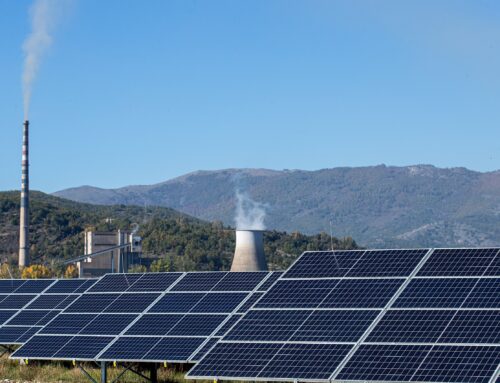Cool the Planet, Fry the Future: The Trap of Solar Geoengineering
October 1, 2025
Playing God with the atmosphere is not a solution to climate change
It turns out humanity can’t even clean up its mess without making another one.
The defenses are varied, but in the end, they are all psychological. We don’t just barricade the door; we barricade the mind. Instead of facing collapse head-on, we invent distractions, rituals, and stories to blunt the edges of dread. Call it resilience, call it denial — either way, it’s survival theater. The walls we build aren’t made of concrete, but of selective memory, scrolling feeds, and convenient half-truths.
And yet, none of it makes the world less overwhelming. Climate breakdown, inequality, surveillance, disinformation — it’s all too much to metabolize at once. So we flinch, delay, rationalize, laugh it off. These are not personal quirks; they’re defense mechanisms, coded into the way we process threat. Some soothe, some numb, some distract. All of them shape how we move through the wreckage.
Some tricks help us cope. Others keep us trapped. And the line between the two isn’t always as clear as we want it to be.
Forget about depressing global averages for a moment and follow me here.
Hurricanes don’t care about theoretical balance sheets. They are creatures of place — born in heat, shaped by wind, fed by water. And over the past 40 years, the North Atlantic basin has seen a bigger spike in hurricane activity than anywhere else. Of course, warmer seas drive storms because the planet is warming, right? Sure, but this is also driven by the chaotic fingerprint of human interference on regional systems — this time, by the very efforts to decrease aerosol pollution.
Mid-century, aerosols from U.S. and European smokestacks drifted across the Atlantic like a hazy umbrella, reflecting sunlight and cooling the ocean below. That cooling tamped down hurricanes. Then came clean-air laws. Scrubbers in coal plants, cleaner ship fuel, and crackdowns on sulfur. Great news for lungs, for sure. But it turns out that by reflecting sunlight back into space, tiny sulfur particles from ship emissions and China’s industrial pollution protected Earth from about a third of the warming caused by human emissions of carbon dioxide. So, with clear skies, the sun came roaring back, the seas heated up, and the storms followed.
You read that right: cleaning up the air made things worse.
Humans are still cooling the climate today by emitting 75 million metric tons of sulfur dioxide into the lower atmosphere, almost entirely as a byproduct of burning fossil fuels. However, global sulfur emissions have declined sharply. Today, they are 48% lower than they were in 1979 and 40% lower than in 2006. China alone has slashed them by about 70%.
There’s little left to remove, which means the temporary cooling shield we once had is gone.
We should celebrate cleaner air, but we also have to reckon with an unintended consequence.
The latest 36-month data release for July 2025 by CERES running average for Earth’s albedo (reflectivity) hit another record low. Since 2014, the loss of that reflective haze has had the same effect as adding 138 ppm of CO₂ into the atmosphere. That effectively pushes us toward 560 ppm CO₂e — the kind of numbers climate scientists once associated with the distant future.
Most concerning is what’s happening above us. A recent study found that low-cloud cover has drastically declined in the northern mid-latitudes and tropics, intensifying the warming effect. And this change may be due to a combination of natural variability, yes, but also to the drop in sulfur emissions.
It’s a toxic trade-off: we choke less, we fry more.
So here’s where the story tilts into science fiction — except it isn’t.
Some researchers argue that if removing sulfur warmed the planet, then we should put it back in the stratosphere to cool it down. A planetary umbrella called Solar Radiation Management (SRM).
Any idea of geoengineering (any deliberate large-scale intervention in the Earth’s natural systems to counteract climate change) sounds wild, sure. But in a sense, we’re already doing it. We’ve increased CO₂ levels by 50% compared to pre-industrial times. We’ve spewed billions of tons of sulfur — even as it shortened lives by the billions. Then we cleaned it up, and the mask slipped. Now the heat is hitting us full force.
So here we are, staring down the paradox of our supercharged atmosphere. Do we dare play God with the sky to buy ourselves time? Or do we, for once, accept the frying pan and confront the real culprit that is turning our planet into a furnace?
Stratospheric Injections
Every time the Earth erupts, it runs an accidental science experiment: pump millions of tons of sulfur into the sky, and the planet cools. Agung in 1963, El Chichón in 1982, Pinatubo in 1991, Hunga-Tonga in 2023. Each one vented sulfur dioxide into the stratosphere, shaded the Earth, and pushed global temperatures down — briefly.
We know this much: volcanic aerosols scatter sunlight, cool the surface, and delay warming at least for a while.
That’s essentially the pitch behind stratospheric aerosol injections: instead of random cooling geoengineering, mimic the volcanoes on purpose. Pump sulfur dioxide into the stratosphere, reflect more sunlight, and buy time. It’s the same trick we’ve been running unintentionally in the lower atmosphere with fossil-fuel pollution — only far more efficient.
Tropospheric particles are raindrops — fleeting, regional, and heavy, they vanish in days, like Saharan dust holding back hurricanes. Stratospheric ones are smoke — drifting, global, and persistent; they linger a year or two.
That staying power means you need around 50 times less sulfur for the same cooling effect. So a stratospheric program would come with at least 100 times fewer health impacts than the catastrophic air pollution experiment we’re still running in the lower atmosphere.
Why We Should Bet On Desperation
Here’s the brutal math: the world is barreling past its own guardrails. We’ve already blown through most of the 1.5 °C budget, and even if we slammed the brakes on emissions tomorrow, we’re still locked into crossing 1.5 °C by the early 2030s.
That’s the case for geoengineering. Not ideology, not techno-fetishism — desperation.
We’re already running an idiotic version of it, where it poisons lungs while muting some of the heat, and volcanic eruptions have already run the experiment for us. So why not flip the script? Why not take a fraction of that sulfur into the stratosphere, and get the soothing cooling while we spare millions of people choking on what we currently call “economic growth.”
It’s disturbingly cheap, too. By some estimates, a few billion dollars a year could hold global temperatures near today’s level, though the costs would increase over time. That’s pocket change compared to the trillions we pour into fossil fuel subsidies and climate disaster clean-ups.
We know that SRM would work to cool the planet; after all, we have plenty of examples of volcanoes doing this naturally. The relatively short-lived nature of stratospheric aerosols (falling out of the atmosphere in a few years) means that any deployment of SRM could be easily adjusted if it results in more or less cooling than initially expected.
This speed is what makes Solar Radiation Management (SRM) both terrifying and tempting. Imagine staring down a looming tipping point — the collapse of Antarctica, or of the Atlantic circulation — and realizing emissions cuts won’t come fast enough. SRM is the emergency brake that buys time: flip it on, cool things down, pray the system steadies long enough for CO₂ removal to catch up. That means any “mistake” could, in theory, be dialed back quickly.
In the best-case scenario, SRM would be deployed only as a stopgap — a way to offset the warming spike from declining sulfur pollution as we finally phase out fossil fuels.
That means any “mistake” could, in theory, be dialed back quickly. But let’s be clear: reflecting sunlight is no cure.
At best, it’s a mask. At worst, it’s a trap we can’t take off.
Why This Is a Billion-Dollar Band-Aid Slapped on a Bullet Wound
So, here’s the seduction: deploy Solar Radiation Management, slash heat deaths, hold back floods and famines, and wait for Carbon Dioxide Removal to catch up. A pause button on planetary collapse.
But we don’t live in that clean, rational, ideal world. We live in a world where short-term profit trumps survival — and where a quick fix can metastasize into dependence.
Yes, stratospheric injections could cool the planet. But they also warp rainfall, threaten the (still fragile) ozone layer, and do nothing to stop ocean acidification or roll back extinctions. The heat may ease, but the seas will still turn corrosive. The crops might get a breather, but wars over “who owns the weather” could ignite the moment a monsoon shows up late.
However, the biggest downside of geoengineering is that it doesn’t dismantle the machine still pumping CO₂ into the air and it doesn’t erase the carbon we keep spewing — it just hides it.
CO₂ lasts for millennia. Half of what we emit today will still be here in 100 years. It takes hundreds of thousands to truly clear. Which means the weather outside your window is déjà vu — the delayed echo of a 350 ppm world. The full weight of today’s 425 ppm is still on its way. And we’re still climbing. Even in so-called “best cases”, we’ll peak around 550 ppm — a world baked far beyond the edge of safety. So, even if the world drives emissions down to zero, the planet wouldn’t cool down for centuries.
And every degree of cooling bought with sulfur is a debt of trillions handed to the future — because if the spraying ever stops, the heat roars back with a vengeance. That’s termination shock: the planetary whiplash that could unravel societies faster than any heatwave.
So the real danger behind geoengineering isn’t some sci-fi catastrophe. It’s complacency. The illusion that we can keep burning, keep consuming, and just spray the sky into submission.
This is not a solution to climate change.
At best, it’s a billion-dollar Band-Aid slapped on a bullet wound. At worst, it locks our children into permanent dependency, condemned to pump sulfur forever or face collapse the moment the system falters.
If SRM ever happens, it should be under rules drawn before panic sets in — not after the first breadbasket fails. Strict limits, relentless measurement, and a clear plan to shut it down. Not as a technocratic escape hatch, but as a desperate stopgap while we slash emissions to zero and pull carbon back out of the sky.
Because stumbling into accidental cooling was one thing.
Stumbling into a permanent crutch would be something else entirely.
The Illusion of Escape
We keep telling ourselves a story: that the future is far away, that someone else will deal with it, that the miracle machine will arrive just in time. But the timeline we thought we had is collapsing. The planetary shocks already unfolding aren’t outliers — they’re previews. And the real impacts of today’s carbon spike are still loading.
So why do we keep flooring the accelerator? Fast shipping, plastic everything, one-click convenience — an economy built on craving, not need. We call it progress, but it’s the same old trap. Like when cars “solved” horse manure and instead gave us oil wars, pollution, traffic deaths, and a destabilized climate. Every fix creates fallout. Every shortcut digs the hole deeper.
Geoengineering is just the latest addition to the “progress traps” list. A shiny, delusional button that promises time but risks locking our children into permanent dependency.
I hope we never need it. That the world will somehow come together and rapidly reduce emissions to limit warming to well-below 2°C this century. But what’s happening now is outside of what anyone anticipated. And there’s no sign of any major worldwide cooperation happening in the meantime.
What if this relentless spike in temperatures isn’t just a blip but a sign that our planet has already entered a new phase of accelerated warming?
This fight cannot be outsourced to machines or miracles. It starts with us. And history shows we can move faster than fear suggests. The Montreal Protocol wasn’t perfect, but it proved that collective, decisive action works. Speed cuts both ways: it can accelerate collapse, or it can drive transformation.
The question is whether we’ll use it to engineer a mask — or a future.
So be loud.
Search
RECENT PRESS RELEASES
Related Post



